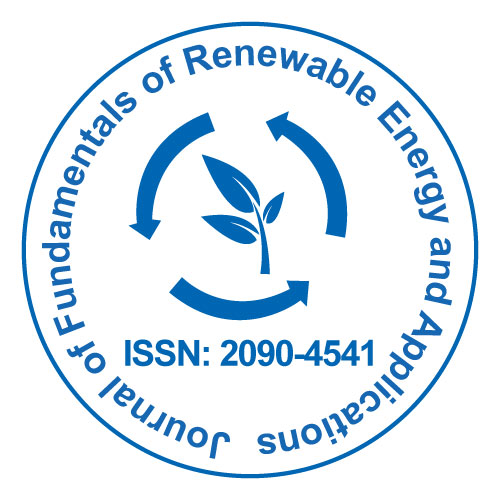
Journal of Fundamentals of Renewable Energy and Applications
Open Access
ISSN: 2090-4541

ISSN: 2090-4541
En-Chin Su1, Bing-Shun Huang2 and Ming-Yen Wey1
1National Chung Hsing University, ROC 2Taiwan Research Institute, ROC
Scientific Tracks Abstracts: J Fundam Renewable Energy Appl
Hydrogen, which possesses some features such as cleaning, high energy conversion, and renewability, is suitable for energy conversion without greenhouse gas emission. Photocatalytic hydrogen evolution is regarded as the promising way to produce hydrogen because of the clean and simple procedure. To enhance the photoexcitation probability of SrTiO3/TiO2 composite material and to facilitate the photo-exited electron delivery among Pt, N-TiO2, and cubic SrTiO3, the TiO2 tube with well electron delivery was selected as the internal layer material for cubic SrTiO3 distribution. The effect of composition on electron delivery, light absorption, and charge recombination rate were discussed in this study. In this study, the Pt/N-TiO2/ cubic SrTiO3/TiO2 tube multi-junction photocatalyst has been developed. XRD and FETEM analysis results indicated that the cubic SrTiO3 particles grew along the surface of TiO2 tube, resulting in a tight contact structure of cubic SrTiO3/TiO2 tube. The N-TiO2 composed with cubic SrTiO3/TiO2 tube revealed 9 times higher hydrogen evolution efficiency under simulated sunlight irradiation than N-TiO2 composed with cubic SrTiO3. The enhanced activity was ascribed to the well electron delivery of TiO2 tube and the well charge separation among N-TiO2, cubic SrTiO3, and TiO2 tube. After modifying the surface of N-TiO2/cubic SrTiO3/TiO2 tube with tiny amount (0.1 wt.%) of platinum (Pt), the multi-junction photocatalyst exhibited 8.5 times higher hydrogen evolution efficiency than N-TiO2/cubic SrTiO3/TiO2 tube. PL analysis results showed that coating Pt could further retard the charge recombination rate of multi-junction photocatalyst due to the well-electron acceptance of Pt. According to the hydrogen evolution and EDTA-2Na degradation results, it was found that using Pt/N-TiO2/cubic SrTiO3/ TiO2 tube could facilitate the waste-to-energy system conversion from EDTA-2Na simulated wastewater.
En-Chin Su is a PhD student study in Energy and Materials Recovery Lab, which is a part of the Department of Environmental Engineering at the National Chung Hsing University, Taichung, Taiwan. She has engaged in research on developing synthesis and characterization of photocatalytic materials for six years. There are over ten references related to alternative fuel (hydrogen and biodiesel) development have been published by our group. In the future, our goal is to develop an efficient photocatalyst which can be photo-excited by sunlight, thus facilitating the waste-to-energy system conversion from real wastewater.
Email: ecsu1014@gmail.com